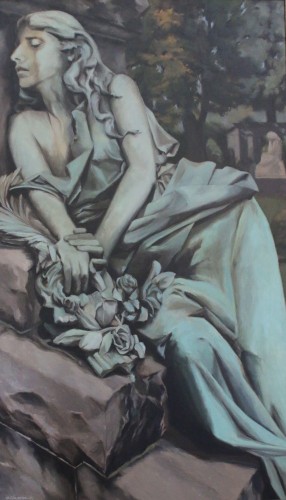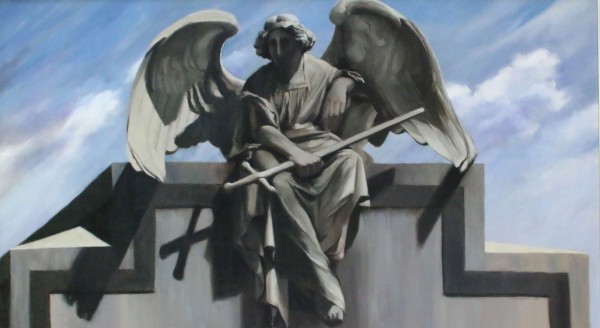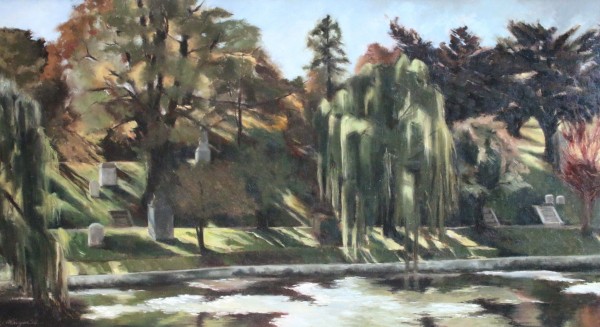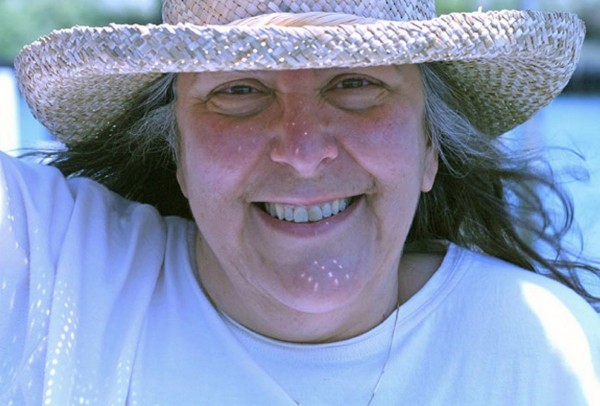Green-Wood has come a long way in its 177 years. It started out in 1838 as a revolutionary idea: no more graveyard burials, but rather a rural cemetery, Christian non-demoninational, with acres of trees and ponds, miles of winding roads and paths, serving New York City and Brooklyn. It then struggled to get people to adapt to this change and adopt a new practice. But, less than two decades after its founding, Green-Wood had become one of America’s leading tourist attractions. And it became THE PLACE for New Yorkers to be buried. But, late in the 20th century, it limited admission to lot owners. And finally it has pivoted back to its roots of welcoming visitors.
This pivot of greater public access began in the late 1980s. And part of that development was a request from Jeanette Koumjian, back in 1988, for permission to paint on Green-Wood’s grounds.
The initial reaction of Green-Wood’s president, Richard Moylan, was to deny permission. But, as he considered the matter, he felt that no harm would come from allowing Jeanette to paint at Green-Wood: “I still love telling the story of how you were really the first artist that painted in Green-Wood with our blessing in modern times but only after I spewed the company line and said no at first. Thank goodness logic prevailed.”
When Moylan’s office was redecorated a few years ago, he purchased one of Jeanette’s paintings to hang right in front of his desk:

And Green-Wood has now been rewarded, decades later, with the donation of two paintings by Jeanette Koumjian. She recently approached Green-Wood with her generous offer to donate two of her favorite paintings of its grounds, dating from the 1988 and 1989.
Ms. Koumjian describes the paintings:
“Monumental Angel” was among the first I painted. I remember fondly your groundskeepers watching out for me, offering a cup of water or bunch of grapes to keep me refreshed in the sun, as well as some of the most insightful, spontaneous critiques I’ve had of my work.

“Green-Wood, Waterside” has become a bit of a historical record in its own right, including those magnificent weeping willows . . . . I worked on this canvas through Summer and into the Fall when it was all I could do to keep the canvas upright against October winds. Loved every precarious minute!

Jeanette Koumjian reflects back on her decision to turn to painting:
In the late 1980s I said good-bye to my 20+ year career in advertising design and visual communication, opting to become a free-lancer. I had during those years simultaneously studied painting. I knew that, if I was to progress, more time must be devoted to my fine art. I wanted to create a body of work based on a single theme. Green-Wood, a most compelling subject, was a place I knew only through its wrought iron fences, never from inside.
Correspondence was exchanged between [Green-Wood President] Richard Moylan and me. He, quite rightly, represented the Cemetery’s concerns, while I sought permission for unfettered access, to set up my equipment and work on site. I was provided a set of conditions to which I agreed, and my project began in earnest.
I loved my concept and hoped it was original. During one conversation, Richard recalled two other artists who also worked in Green-Wood. I felt momentarily deflated, that I might have been preempted, ’til he explained they were Currier and Ives!
I spent days driving through the cemetery, familiarizing myself with terrain, structures, monuments, foliage and, inevitably, inscriptions that are history lessons in themselves. As I went, I noted on a map provided by Green-Wood those areas I thought would make interesting paintings. In subsequent days, I photographed them all, then curated a reference group of eight images which would comprise my Green-Wood Collection.

I worked on all canvases on site, weather permitting. Over several years, I started in Spring and continued until Autumn when brisk winds sent my canvases somersaulting off my easel. If there was an interment in progress nearby, I stopped work and just stood still until the family had driven off. I would see attendees of a funeral pointing at me and I had this hope that my presence, however briefly, distracted them from their grief. Occasionally, some would come over to see my work, then return to their family, as if they were relieved, that they weren’t leaving the deceased all alone. I may have projected these interpretations, but they seemed perfectly natural and very real to me.
I did not expect the number of people who make regular visits to their loved ones. Becoming familiar faces to me, and vice versa, they tracked and encouraged the progress of my artworks. Bolder admirers pulled up their cars along the road outside the cemetery’s perimeter. They freely shouted critiques, wonderment and suggestions on pricing!
The groundskeepers became my acquaintances, protectors and worthy critics. They took such pride in their work (and workplace), and I believe we shared a mutual respect. Their routine came mid-day, a big green van gathered up the crews for lunch, but not before they drove by my site, men seated along the tail-gate, legs dangling overboard. The driver slowed, some might jump off for a quick critique, then off they went. These fellows knew how difficult it was to work out of doors for hours, so they frequently offered me ice water or a cool piece of fruit. They nick-named me Raphaela, no small compliment from the Italians among the gardeners. I do think art appreciation is bred in their bones, as they gave me the most valuable critiques ever. I mean ever! When I was working on the canvas which hangs in Richard Moylan’s office, one of the gardeners cautioned me that I was standing just a couple feet away from an in-ground yellow-jacket (?) nest. I was totally oblivious. Had I taken one step sideways, I would have landed in it. These fellows made me feel safe, cared for and welcome. I will never forget their many kindnesses.
When I conceived of this project, I saw it as highly personal, even a bit eccentric. To my surprise, my Green-Wood paintings consistently evoke emotional, sometimes profound responses. In addition, everyone knows someone from Brooklyn, and I was thrilled to see how many people know of Green-Wood as well. I continued my work in the cemetery until three residency grants diverted me to New Mexico, and a new series of paintings focused on Carlsbad Caverns, Santa Fe and Taos.
Green-Wood has changed much over the years, some roads/paths reconfigured, new structures, exciting projects ahead, the variety of creativity that finds expression there through its many programs and tours. I am proud to be a small part of that history. In fact, my painting “Green-Wood, Waterside,” provides a record of what was, including the great weeping willows, now gone. Change is inevitable, but the extravagant beauty, intimate stories and remarkable history that Green-Wood has to share are utterly timeless.
I am of the belief that the closer to one’s nature and heart an effort strikes, the greater the reward inevitably is. The Green-Wood project was that for me, started by an aspiring artist with the newfound gift of time, hoping to define a unique vision. The clarity of it all and the influence of angels who crossed my path —Richard, groundskeepers, the public, my fans— eased my way.
Ms. Koumjian, by her vision, has opened up Green-Wood to other artists–painters, photographers and sketchers alike–who since she obtained permission in the late 1980s to work there, have created their art at Green-Wood. And she has made a further contribution. As she concludes: “As many Green-Wood paintings as I’ve sold, I was never eager to do so with these. I have always hoped that they might remain together . . . just hoping I can find them a worthy home.” And now she has done so; they will have an honored place at Green-Wood for generations to come.
Another wonderful tale from
Greenwood. I look forward
to each story and am always
amazed at the history lying
inside her gates..
Thanks! After all of my years at Green-Wood, I am still amazed at the many extraordinary stories that come to light.
Jeanette – You have not changed a bit and your work continues to move me. So glad to see the world is enjoying you and your creativity.
Shelley, Thanks so much for your kind words…I’ve just now seen them. Don’t recall responding before. Green-Wood was most inspiring. Hope you are well. Still in Brooklyn?